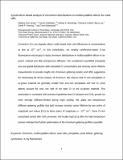| dc.contributor.author | Coletti, Gianluca | |
| dc.contributor.author | Lai, Barry | |
| dc.contributor.author | Jensen, Mallory Ann | |
| dc.contributor.author | Hofstetter, Jasmin | |
| dc.contributor.author | Morishige, Ashley Elizabeth | |
| dc.contributor.author | Fenning, David P | |
| dc.contributor.author | Buonassisi, Anthony | |
| dc.date.accessioned | 2018-11-06T17:27:03Z | |
| dc.date.available | 2018-11-06T17:27:03Z | |
| dc.date.issued | 2015-05 | |
| dc.date.submitted | 2015-04 | |
| dc.identifier.issn | 0003-6951 | |
| dc.identifier.issn | 1077-3118 | |
| dc.identifier.uri | http://hdl.handle.net/1721.1/118922 | |
| dc.description.abstract | Chromium (Cr) can degrade silicon wafer-based solar cell efficiencies at concentrations as low as 10¹⁰cm⁻³. In this contribution, we employ synchrotron-based X-ray fluorescence microscopy to study chromium distributions in multicrystalline silicon in as-grown material and after phosphorous diffusion. We complement quantified precipitate size and spatial distribution with interstitial Cr concentration and minority carrier lifetime measurements to provide insight into chromium gettering kinetics and offer suggestions for minimizing the device impacts of chromium. We observe that Cr-rich precipitates in as-grown material are generally smaller than iron-rich precipitates and that Cr[subscript i] point defects account for only one-half of the total Cr in the as-grown material. This observation is consistent with previous hypotheses that Cr transport and CrSi₂ growth are more strongly diffusion-limited during ingot cooling. We apply two phosphorous diffusion gettering profiles that both increase minority carrier lifetime by two orders of magnitude and reduce [Cr[subscript i]] by three orders of magnitude to 10¹⁰cm⁻³. Some Cr-rich precipitates persist after both processes, and locally high [Cr[subscript i]] after the high-temperature process indicates that further optimization of the chromium gettering profile is possible. | en_US |
| dc.description.sponsorship | United States. Department of Energy (Contract DE-EE0005314) | en_US |
| dc.description.sponsorship | National Science Foundation (U.S.) (Contract EEC-1041895) | en_US |
| dc.description.sponsorship | United States. Department of Energy (Contract EEC-1041895) | en_US |
| dc.description.sponsorship | National Science Foundation (U.S.) (Grant 1122374) | en_US |
| dc.publisher | American Institute of Physics (AIP) | en_US |
| dc.relation.isversionof | http://dx.doi.org/10.1063/1.4921619 | en_US |
| dc.rights | Creative Commons Attribution-Noncommercial-Share Alike | en_US |
| dc.rights.uri | http://creativecommons.org/licenses/by-nc-sa/4.0/ | en_US |
| dc.source | Other repository | en_US |
| dc.title | Synchrotron-based analysis of chromium distributions in multicrystalline silicon for solar cells | en_US |
| dc.type | Article | en_US |
| dc.identifier.citation | Jensen, Mallory Ann et al. “Synchrotron-Based Analysis of Chromium Distributions in Multicrystalline Silicon for Solar Cells.” Applied Physics Letters 106, 20 (May 2015): 202104 © 2015 AIP Publishing LLC | en_US |
| dc.contributor.department | Massachusetts Institute of Technology. Department of Mechanical Engineering | en_US |
| dc.contributor.mitauthor | Jensen, Mallory Ann | |
| dc.contributor.mitauthor | Hofstetter, Jasmin | |
| dc.contributor.mitauthor | Morishige, Ashley Elizabeth | |
| dc.contributor.mitauthor | Fenning, David P | |
| dc.contributor.mitauthor | Buonassisi, Anthony | |
| dc.relation.journal | Applied Physics Letters | en_US |
| dc.eprint.version | Author's final manuscript | en_US |
| dc.type.uri | http://purl.org/eprint/type/JournalArticle | en_US |
| eprint.status | http://purl.org/eprint/status/PeerReviewed | en_US |
| dc.date.updated | 2018-10-31T15:53:52Z | |
| dspace.orderedauthors | Jensen, Mallory Ann; Hofstetter, Jasmin; Morishige, Ashley E.; Coletti, Gianluca; Lai, Barry; Fenning, David P.; Buonassisi, Tonio | en_US |
| dspace.embargo.terms | N | en_US |
| dc.identifier.orcid | https://orcid.org/0000-0002-5353-0780 | |
| dc.identifier.orcid | https://orcid.org/0000-0001-9352-8741 | |
| dc.identifier.orcid | https://orcid.org/0000-0002-4609-9312 | |
| dc.identifier.orcid | https://orcid.org/0000-0001-8345-4937 | |
| mit.license | OPEN_ACCESS_POLICY | en_US |
